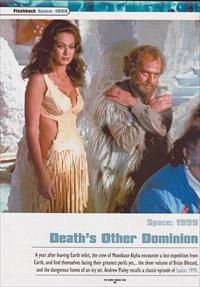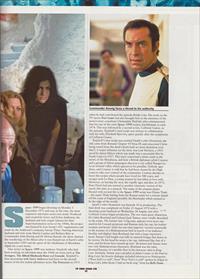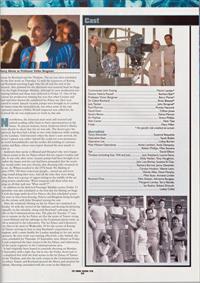Death's Other Dominion Fantasy Flashback
Reviews from TV Zone, "the monthly magazine of cult television", an early 1990s UK genre magazine
by Andrew Pixley
TV Zone 175 (April 2004) p30-34. The last time the magazine covered the series in Fantasy Flashback was 1995 (and the first was 1989). Nine years on, Pixley has a much more analytical approach with production dates and a very full cast list.





A year after leaving Earth orbit, the crew of Moonbase Alpha encounter a lost expedition from Earth, and find themselves facing their greatest perils yet... the sheer volume of Brian Blessed, and the dangerous fumes of an icy set. Andrew Pixley recalls a classic episode of Space: 1999.
pace: 1999 began shooting on Monday 3 December 1973 and was, at the time, the most expensive television series ever made. Produced and created by Gerry and Sylvia Anderson, the husband and wife couple famous for their Supermarionation series of the 1960s, the project was backed by Grade's ITC organization and made by the Anderson's company, Group Three. Starring American husband and wife team Martin Landau and Barbara Bain as Commander John Koenig and Dr Helena Russell, the show charted the wanderings of the Moon after it was blasted out of Earth's orbit in September 1999 and the quest of the inhabitants of Moonbase Alpha for a new home.
One writer on Space: 1999 was Anthony Terpiloff, who had been working on television since the 1960s on series such as The Avengers, The Alfred Hitchcock Hour and Ironside. Terpiloff's first association with Gerry Anderson had been on the second season of the live action adventure series The Protectors in 1973 when he had contributed the episode Border Line. His work on the TV movie Poet Game had also brought him to the attention of the series's story consultant Christopher Penfold, who commissioned him for one of the early Space: 1999 scripts, Earthbound, in early 1974. This was followed by a second script, Collision Course, in the summer. Terpiloff's next script was written in collaboration with his wife, Elizabeth Barrows, quite quickly after the completion of Collision Course.
Terpiloff's new script was entitled Death's other Dominion; the title came from Romans Chapter VI Verse IX and concerned Christ being raised from the dead ('death hath no more dominion over him'). A major influence on the story was Lost Horizon, a 1933 novel by James Hilton which was made into a successful film by Frank Capra in 1937. This story concerned a plane crash in the snows of the Himalayas, and how a British diplomat called Conway and a group of fellow passengers discover a city called Shangri-La in an isolated valley which appears to be paradise. Nobody ages there, and Conway is told that he had been chosen by the High Lama to take over control of the community. Conway decides to leave this utopia where people have lived for 500 years, and escapes with Lo-Tsen, a young woman he has fallen in love with. However, on leaving the area, she rapidly ages and dies. In 1973, Peter Finch had just starred in another cinematic version of the novel, this time as a musical. The name of the utopian planet blessed with eternal life in the Space: 1999 script was Ultima Thule - the name Thule hailing from the Roman name for a remote island off the coast of England (possibly the Shetlands) which seemed to be the edge of the world.
Death's Other Dominion was Episode 14 in production. The final draft was completed on Friday 23 August 1974 with a shooting script finalized on Wednesday 28 August, just after Collision Course began production. The two main guest characters, Dr Cabot Rowland and Colonel Jack Tanner, were vividly described in the script. The former was 'a big man, appears even more out- sized in his Cossack greatcoat and Russian style fur cap, his leather trousers and boots' while his one-time superior 'cavorts ecstatically in the manner of a Shakespearean fool in search of an audience. Smaller and slighter than Rowland, but with a large expressive head, Tanner's full length coat falls in tattered fringes that dance as he moves. On his head he wears a fur cap, fashioned like that of a fool, and his boots have turned-up toes.' Rowland and Tanner were two very Shakespearean characters. Rowland was the ruler, doomed because of a terrible flaw in his character akin to King Lear. Similarly, Tanner was a prophet in Julius Caesar or the Fool in King Lear; his bizarre dialogue included references to Shakespeare ("Poor Jack's a cold". from "Poor Tom's a cold" spoken by Edgar in King Lear), John Keats ("and no birds sing" from La Belle Dame Sans Merci) and Gilbert and Sullivan ("as he sighed for the love of a lady" from Yeoman of the Guard) amongst others.
The director on the episode was Charles Crichton, who had worked as part of a rotating team of three/four directors since the start of the series; since January 1974 he had helmed the episodes Matter of Life and Death, Earthbound (filmed March 1974), Guardian of Piri (filmed May 1974) and The Last Sunset (filmed July 1974). Crichton had been in films since the 1940s, working on comedies such as The Lavender Hill Mob and The Titfield Thunderbolt at Ealing Studios before directing episodes of Danger Man, Man in a Suitcase and Strange Report and joining Group Three on The Protectors.
The main guest role in the episode, that of Dr Cabot Rowland, went to Brian Blessed, who had found fame as PC Fancy Smith in the BBC police drama Z Cars and gone on to appear in series such as The Three Musketeers and Arthur of the Britons. Jack Tanner was played by John Shrapnel who had portrayed Sussex in the BBC's prestige production Elizabeth R.
One of the major design requirements for the episode was the Ice Palace composite set (including Laboratory and Communications Area) beneath the surface of Ultima Thule. Production designer Keith Wilson was approached by an outside contractor who claimed that he could create a special snow and ice set on Stage M at Pinewood using a spray gun. However, the formaldehyde creating the ice also let off fumes, and soon those working on the set began to cough and splutter. Nevertheless, Wilson's team continued construction by collecting all the debris from around Pinewood Studios and covering it in the fake ice over a weekend.
Shooting on Death's other Dominion began on Monday 9 September 1974 on Stage L at Pinewood Studios where the standing sets of Main Mission and Koenig's Office were housed. The scenes filmed on this day required most of the regular cast only, and was the only day on which actors such as Clifton Jones (Kano) and Zienia Merton (Sandra) were needed. In the meantime, the snowscape set for Ultima Thule had been completed in the adjacent area.
Prentis Hancock was also required as Paul Morrow for the second day of shooting on Tuesday 10 when he was needed for monitor shots on scenes set in the Command Module of the Eagle which had been relocated to Stage H. The afternoon was then scheduled for the scenes on the surface of the Ice Planet where Helena and pilot Alan Carter became lost in Act One and Carter returned to Eagle One.
Barry Morse rejoined the cast as Victor Bergman on Wednesday 11 September, alongside Blessed and some of the other guest cast. These scenes, again on the surface-of Thule, were scheduled to be the material of Koenig and Bergman in the blizzard, and their rescue by Rowland and the Thulians. The set was then scheduled for the first work on Thursday 12 with the sequences of Koenig and Rowland watching Eagle One lift off and the end of the blizzard. Also planned for the afternoon was material back on Stage H in the Eagle Passenger Module. although by now production was running behind and these were deferred to Friday 13. One of the reasons for production running late was that when Landau and Bain had been shown the completed Ice Palace set, their eyes started to water. Special vacuum pumps were brought in to combat the fumes from the formaldehyde, but when some of the cast expressed concern a Public Health inspector was called for; he declared the set was unpleasant to work in, but safe.
Nevertheless, the American stars were still worried and started sending cables back to their representatives in the States. To placate matters, Gerry Anderson hired a Harley Street doctor to check that the set was safe. The doctor gave his approval, but then had a drink or two with Anderson while waiting for the Landaus. Unfortunately when the show's stars arrived. the doctor's speech was rather slurred (he could not even pronounce the word formaldehyde) and his verdict did nothing to convince Landau and Bain, whose own expert deemed the area unsafe to work in.
Anderson then spoke to Blessed and Shrapnel who were happy to shoot scenes in the Ice Palace which did not require Landau and Bain. It was only after more vacuum pumps had been brought in to combat the fumes and the cast had been persuaded that the worst they would suffer was sore throats, that shooting fully resumed on the set. As Wilson recalled in the 1976 book The Making of Space: 1999, "All these important people... turned up and were going round doing their tests. And all the time they were doing them, there was a group of riggers sitting in the middle of the set eating prawn sandwiches. When someone told them what was going on all they said was 'What smell?'!"
In addition to the deferred Passenger Module scenes, Friday 13 September was also scheduled as the first day for filming on Stage M with the large multi-level Ice Palace; the first scheduled scenes shot were to have been Koenig, Helena and Bergman being brought into the colony, with John Shrapnel joining the cast.
After the weekend. filming on the Ice Palace set continued on Monday 16 with the revival of the Alphans and Koenig breakfasting originally on the schedule, along with Rowland's sabotage of the radio in the Communications area. The plan for Tuesday 17 was then to remain on the Ice Palace set (for the scene of Tanner trying warn Helena) and the sabotage in the Communications room, as well as material in the Laboratory. The Ice Palace and Laboratory were then to be used on Wednesday 18 for the scenes of Koenig and Tanner arriving in time to stop Rowland's experiment on Bergman, with a stunt double for Landau standing by for any action sequences. By now work was running effectively a day behind; the scenes scheduled for Thursday 19 September were filmed on Friday and comprised the later scenes in the Ice Palace and Laboratory, and the repair sequence in the Communications area.
It had originally been hoped to conclude shooting on Monday 23 September with a light day, but in fact the Friday shoot had to be completed first with the final scenes in the Ice Palace of Tanner and the Thulians, and also the early scenes in the Communications area where Tanner and Rowland spotted the Moon and awaited the Alphans. Shooting concluded with the scene in the Shipyard Balcony where the Phoenix was being built, and for the material in the Cave of Revered Ones.
Special effects filming for the series at Bray Studios included the model shots of the surface of Ultima Thule (indeed, one shot of the planet's surface was later reused in the episode One Moment of Humanity in the show's second season). The model of the partially constructed Phoenix spaceship seen briefly by the Alphans was built by effects expert Martin Bower and inspired by the rocket seen in George Pal's 1951 movie When Worlds Collide. The opening captions for the episode were shown over model shots of Eagle One entering the smoggy atmosphere of Ultima Thule. Only five early episodes of Space: 1999 had been accorded newly composed music scored by Barry Gray (Matter of Life and Death recorded on Thursday 14 March 1974, Breakaway recorded the next day, Black Sun on Thursday 25 April, Ring Around the Moon on Monday 6 May and Another lime, Another Place on Tuesday 25 June). Music was drawn from these episodes to create the score for Death's Other Dominion. Augmenting this was material composed by Gray from the Joe 90 episode Big Fish (recorded Wednesday 20 March 1968).
On Thursday 2 October 1975, ATV Midlands and Yorkshire were two of the first regions to transmit Death's other Dominion which appeared as the fifth episode on the original ITV run; London Weekend Television transmitted the show on Saturday 4 October, with Granada screening it on Friday 24 October. In America, the episode appeared in syndication on various channels in the final week of 1975. The review of the series by Newsweek made reference to "Camelot locator beams" because the reviewer misheard Koenig telling Bergman and Helena to use their commlock locator beams if they get lost in the blizzard.
EC Tubb novelized the episode as part of the paperback Space: 1999 - 4: Collision Course published by Orbit Books in October 1975. A hardback edition followed in December from Dobson Books Ltd, while the same volume appeared in paperback in the US (this time with photographs) from Pocket Books in February 1976. An alternate novelization appeared in a Italian hardback, Spazio 1999: 11 - La Granda Dominarice, from Gianni Padoan, published by AMZ in July 1978 as Il pianeta di ghiaccio (The Planet of Ice), while a German comic strip version, Todliches Eis (Deadly Ice) appeared as part of the Mondbasis Alpha 1 strip in Issue 10 of the comic Zack in May 1978. An abridged version of the episode was also adapted for a record with new cast performing a truncated script and issued on LP by Power Records in 1975 along with Breakaway and Mission of the Darians.
Death's other Dominion was re-run on the ITV regions a couple. of times through to the early 1980s, since when it has appeared on the satellite channel Bravo (first appearing on Tuesday 19 October 1995) and then networked on BBC2 on Monday 24 August 1998. In the UK, the episode was released on VHS as part of Space: 1999 Volume 6 by ITC in July 1992, and has subsequently appeared on the DVD Space: 1999 Volume 4 from Carlton in June 2001. It has also appeared on laserdisc and DVD in America, Japan and France.